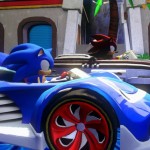Game Review: Sonic & All Stars Racing Transformed
I’m hardly a kart racer fan, this being the second one I ever bought; the first being Mario Kart Wii. However, the big difference between the former I acquired after listening to the soundtracks from the game randomly. While Mario Kart’s characters, stages and music all bore the series’ trademark look and feel, the Sonic one felt much more expansive, comprising a much more diverse range of characters, stage types, and game mechanics. Being tghe big a SEGA fan I am, this game was impossible to ignore. Ok, it also helped I had $15 in Gamestop credit to help me purchase this.
The massive ecosystem of game universes that SEGA has developed since the Master System days to the PS2 are well-represented here. You have throwbacks like Alex Kidd, Joe Musashi (Shinobi) and Gillius Thunderhead (Golden Axe) along with a huge rogue’s gallery (pun intended) of Dreamcast alumni like Ulala and Pudding (Space Channel 5); Beat and Gum (Jet Set Radio); and Vyse (Skies of Arcadia). Inbetween here you have more your fair share of Sonic universe characters both good and bad, one-offs (AiAi and MeMe from Monkey Ball, the vehicle from Daytona USA) and some commecial tie-ins: Wreck-It Ralph and Danica Patrick. Personally, I don’t care about the last two but they’re far from being the worst possible additions.
To complement these characters, many characters also have stages from the games they come from. And, some stages have no characters but I’m really happy Sumo Digital really tried to represent as much as possible. In some ways, the stages are an even better respresentation than any usable character that may be included. After Burner, Burning Rangers, Bill Hatcher and the Giant Egg, and Outrun are some of the bigger examples. I wish they had a Space Channel 5 stage but them’s the breaks.
Along with each stage you had remixed or resampled theme songs from the game. I found this to be the most enchanting part of playing as this could have really made or broken the aesthetic and nostalgic feel of the game. Some pieces will be known only if you played the Japanese version of a respective title. Others are original but capture the essence of the game that it’s representing. Take the following piece from the Samba Studios stage; it’s not from either Dreamcast released game, but feels right at home.
The final piece is the “transformed”part of the series title. Each character has three possible vehicle forms: kart, boat, airplane with the final form working in three dimensions and being slightly harder to control but is faster than the other two. Stages themselves can utlize anywhere from one to three of those forms, sometimes even changing mid-race so you find yourself only driving the kart for two laps then suddenly turning into a boat for the final one. These transformations are automatic but can be delayed or premature sometiimes if you find a short- or long-cut on the course. This is a great addition and adds some much needed depth to the kart racing genre.
Overall, I’m happy I put the effort in to learn this game and squeeze as much out of it as I could. Also, it’s a convenient excuse to break out when friends or family are over as I do not have a party friendly game. Unless you count Tetris.
For a parting note, here are my three favorite stage songs in the game:

Share Your Thoughts